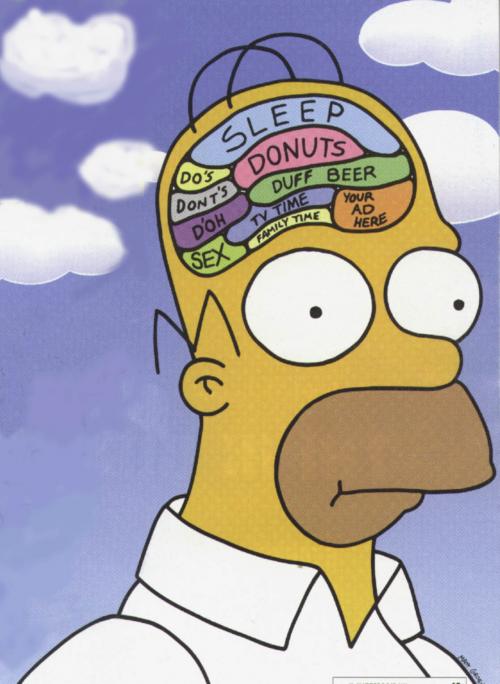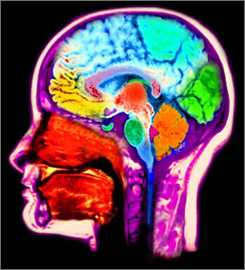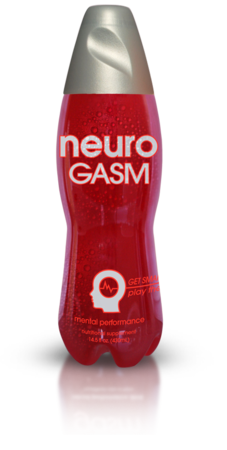Neurobabble

Are there REALLY parts of the brain dedicated to categories of thoughts like some reports say?
The field of neuroscience has undoubtedly expanded over the past two decades, and the explosion of all this cutting-edge discovery has inevitably lead to its proliferation in our culture. However, the spread of interest to the general population has begun to instigate the problematic phenomenon of what some scientists deem “neurobabble”. It refers to the overly simplified and misinterpreted information that many contemporary writers use to appeal to the public. Neurobabble in recent pop-science books and articles often engenders false conclusions and denies proper understanding about how the brain really works.
Society’s absorption of this ‘neurobabble’ has somewhat elevated the brain into a cultish status, mythologizing its functions and romanticizing the promise of research applications. Anyone could walk into a bookstore now and come across a magazine article exhibiting vibrantly colored images of brain scans coupled with a beguiling title such as “The Part of The Brain Responsible for Being in Love!” It’s the kind of phrase that fools people into thinking a psychological event can be equivalently replaced by a biological one. And it attracts many of us because it appears to offer explanatory answers to the questions we really care about. But to believe that something as ambiguous and abstract as love can be simply defined as a localized function is not only flawed reasoning, but utterly unsupported by the neuroscientific evidence of the brain as an extremely interconnected and dynamic network.
 The media is particularly fond of fMRI studies because the visual aspect seems to make the claims of neurobabble more persuasive. One fallacy people unfamiliar with neuroscience are apt to assume is that the particular part of the brain that “lights up” in the MRI scanner is accountable for the behavior, emotion, etc. of the person inside. But the machines aren’t directly measuring any real-time, chemical or electrical neural activity; rather, they measure changes in oxygen content in blood. The more neurons fire, the more O2 is used. So activity in the area is being measured, but there’s always ‘background noise’.
The media is particularly fond of fMRI studies because the visual aspect seems to make the claims of neurobabble more persuasive. One fallacy people unfamiliar with neuroscience are apt to assume is that the particular part of the brain that “lights up” in the MRI scanner is accountable for the behavior, emotion, etc. of the person inside. But the machines aren’t directly measuring any real-time, chemical or electrical neural activity; rather, they measure changes in oxygen content in blood. The more neurons fire, the more O2 is used. So activity in the area is being measured, but there’s always ‘background noise’.
Imagine a scenario in which two different men volunteer for an experiment in which they both view pictures of their wives in an fMRI, and those conducting the study look at the areas thought to be involved in ‘empathy’ or ‘love’ based on previous research. Firstly, all brains are unique. There is a lot of variation in background brain activity, including how susceptible neural patterns can be to experimental conditions. Inside an enormous, loud, hollow machine certainly isn’t a natural environment. So can we really conclude that one man loves his wife more than the other because of the results?
Because of the rich technical and conceptual sophistication involved in the questions we really want answered, it’s tempting even for specialists to make overstatements and say things that make no sense. David Eagleman (a neuroscientist at the Baylor college of Medicine) had said in his book “Incognitio: The Secret Lives of The Brain” that neuroimaging scans may someday be used to identify those with the potential to commit crime. He goes as far to say that (quite Orwellian-ly) “some people will need to be taken off the streets on the basis of their fMRIs”.

Pop culture loves twisting neuroscience!
A pod cast by Rationally Speaking & NYC Skeptics used a metaphor to depict the manner of how the brain works and shed light on the neurobabble issue:
Suppose you were running a desktop computer and you were observing which components of the hardware were active when a procedure (we’ll call it Graphics Displays) was carried out. You notice one part of the computer is active when graphics are displayed, but when that active part is taken out, they cannot be displayed. So you assume THAT component causes the display. But… it could be that the graphics are run by another component, but the process of graphics display is so energy intensive that it produces an amount of heat that activates the computer’s cooling device, always active during graphics. So that initial component could actually be for regulating the machine’s temperature, and some automatic safeguards recognized its absence, preventing graphics displays.
The moral of the metaphor is that correlation never implies causation. As a neuroscience student myself, I’ll urge you to be wary of bad claims. Ask yourself questions when you come across them. Here’s a reliable method: Assume the brain is the most complex object in the entire universe. If a claim about it sounds too simple to be true, then it probably is!
Neurobabble obscures deeper significance of brain science – UCLA Today
The End of Evil?
Neuroscientists suggest there is no such thing. Are they right? – Slate
Neurobabble – Rationally Speaking